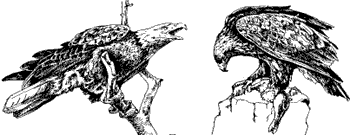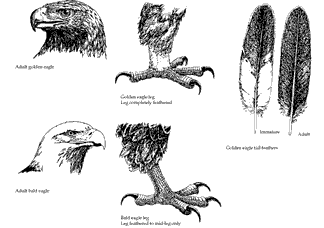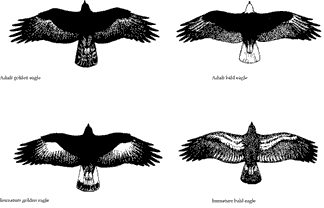Eagles | Eagle Overview | Eagle Damage Assessment | Eagle Damage Management | Eagle Resources | ICWDM | Wildlife Species Information
Figure 1. Left, Bald eagle, Haliaeetus leucocephalus; right, Golden eagle, Aquila chrysaetos
Identification
Eagles are the largest bird of prey in North America. When hatched, eaglets have thick, light-colored down that is replaced with dark feathers within 5 to 6 weeks. Eagles have long sharp talons by which they capture and kill prey animals. The tarsi (lower legs) are feathered to the toes on golden eagles but are bare on bald eagles (Fig. 2). Golden eagles weigh from 7 to 13 pounds (3 to 6 kg) as adults and have a wingspread of 6 to 7 1/2 feet (1.8 to 2.3 m); females are about one-third larger than males.
The plumage color of golden eagles changes with age. Birds in their first year are predominantly dark brown, with considerable areas of white on the underside of their wing flight feathers. The tail has a broad white band with a dark terminal band at the tip. The back of the neck may or may not appear gold or bronze, depending upon light conditions and the individual bird. This color is what gave the golden eagle its common name. Adult eagles are dark brown or bronze (Figs. 2 and 3).
Bald eagles weigh from 9 to 15 pounds (4 to 7 kg) as adults and have a wingspread of 7 to 8 feet (2.1 to 2.4 m). As in golden eagles, females are about one-third larger than males. Bald eagle plumage color also changes with age. Juvenile bald eagles generally are mottled brown or nearly black and resemble adult golden eagles. These juveniles have no distinct white patches. Their tail and wings are mottled brown and white on the underside in contrast to the characteristic white patches under the wings and the Golden eagle tail feathers white-banded tail of juvenile golden eagles. Although adult bald eagles of both sexes have the white head and tail, they do not develop these characteristics until they are 4 to 5 years of age or older (Figs. 2 and 3).
General Biology, Reproduction, and Behavior
Nesting Behavior
Eagle courtship displays consist of a series of “roller coaster” dives and other aerial maneuvers. These characteristic maneuvers may be seen nearly any time of the year, but are most common just before and during the late winter breeding season. Aerial displays made during other seasons may serve to identify territorial boundaries and maintain pair bonds between adults.
Eagle nests of sticks and twigs are built either on cliffs or in trees. Nests can be very large, sometimes up to 8 feet (2.4 m) wide and deep. The same nests may be used several years, becoming larger as new material is added each year. Eagles usually have several nests in a vicinity and may use alternate sites.
Nesting can begin as early as February in the south and as late as June in the north. At nesting time, an adult pair builds new nests or repairs old ones. Often, a single pair will build or repair two or three nests during a single sea-son. These alternate nests are legally defined as “active” and are protected by law. The nesting territory of golden eagles varies from about 3 to 65 square miles (8 to 168 km2) per pair.
Bald eagles seem less antagonistic to other nesting pairs, and their nesting territories, typically near water, may be much smaller. Studies in Alaska have shown that bald eagle nests may be spaced as closely as 1/4 mile (0.4 km) apart along rivers, with nesting territories as small as 30 to 40 acres (12 to 16 ha) in some cases. This may be due to more plentiful food near water.
Usually, 2 (1 to 3) white or mottled brownish eggs are laid after nesting behavior begins. The eggs hatch after a 35- to 45-day incubation period. Both adults hunt and secure food for the young, with the female doing most of the incubating, feeding, and brooding. Young eagles become strong enough to tear meat apart by 50 days of age. They are fully feathered and ready to leave the nest 65 to 70 days after hatching. Although the young are as large as the adult birds at this time, their parents may continue to provide them with food and protection for as long as 3 months after they leave the nest.
Not all eagle eggs hatch, and the death rate of young eagles, as in other birds of prey, is high. Young eagles are antagonistic toward each other and the stronger often kills or causes the weaker to die of starvation. Losses due to exposure, diseases, parasites, and predation occur while the young are still in the nest. Up to 75% of the young eagles die during their first year due to starvation, disease, and causes directly or indirectly associated with humans.
Illegal shooting, chemicals, trapping, and power line electrocutions account for a large number of eagle fatalities. Injuries resulting from accidents such as flying into power lines or being hit by vehicles while feeding on road-killed animals also occur.
Dispersal and Migration
Juvenile golden eagles leave the nesting territory as early as May in the Southwest and as late as October or November in the North. Many of the golden eagles that breed in the northern United States and Canada migrate south for the winter. They arrive in the southwestern United States as early as October and reach peak numbers in December and January in Texas and February and March in New Mexico before migrating back north. Only resident birds remain by late May. Golden eagles breeding in the more temperate climates south of Canada often remain in the same region year-round. Many northern golden eagles migrate through areas occupied by resident eagles to areas farther south.
Bald eagles usually are found in coastal areas, along lakes and rivers, and on mountain ridges. Usually, they are seen soaring or sitting on commanding snags along bluffs or shores. Pairs sometimes are observed together. After the nesting season, they may congregate in areas where food is more readily available, and then large numbers may roost in the same tree. Immature birds also may roost together during the winter.
Bald eagles will winter as far north as open water and food are available, migrating out of more northerly nesting areas. Returns from banded bald eagles indicate that birds that nest in Florida often migrate to the northeastern states and southern Canada in midsummer and return in early fall. Returns from birds banded in Saskatchewan indicate that some move as far south as Texas and Arizona.
Eagle Populations
Research indicates that golden eagles are maintaining static populations in areas undisturbed by humans. The wintering population south of Canada is estimated at 63,000 birds. Aerial surveys conducted by the USFWS in 12 western states show average densities of about 10 golden eagles per 100 square miles (4/100 km2) in midwinter study areas. Golden eagles also winter in parts of Alaska, Canada, and Mexico; however, the number in this latter group would not likely exceed 10,000 birds.
Current population survey information indicates a sizable and healthy population of golden eagles in the western states. The current breeding population for 17 western states is estimated at 17,000 to 20,000 breeding pairs. Information indicates a slight de-cline in the western population as a whole, with drastic declines in some specific areas associated with in-creased human activity.
Bald eagles occur across the continent from northern Alaska to Newfound-land, and south to southern Florida and Baja California. They are found on Bering Island and the Aleutian Islands. Two subspecies are recognized: the southern bald eagle (H. l. leucocephalus) and the northern bald eagle (H. l. alascans). The primary difference in appearance is size, the northern race being larger and heavier. There is a gradual increase in size from south to north.
The northern bald eagle population in Alaska is estimated at 35,000 to 40,000. In 1989, the breeding population of bald eagles in the continental United States (excluding Alaska) was estimated to be about 2,673 pairs. This estimate included both races. The nationwide January eagle count sponsored by the National Audubon Society indicated about 3,700 birds each year from 1961 through 1966. The annual midwinter counts coordinated by the National Wildlife Federation since 1979 have ranged from about 9,000 birds to more than 13,000 in the contiguous 48 states. In 1989, 11,610 bald eagles were counted in key wintering areas. The 1989 count does not represent a comprehensive national count, so it is not directly comparable to earlier counts. These January counts indicated four areas of greatest abundance nationwide: the upper half of the Mississippi Valley, the Northwest (Washington, Oregon, Idaho, and Montana), Florida, and the Chesapeake Bay area.
Eagles | Eagle Overview | Eagle Damage Assessment | Eagle Damage Management | Eagle Resources | ICWDM | Wildlife Species Information
Range
Golden eagles in North America occur in greatest numbers from Alaska southward throughout the mountain and intermountain regions of the West and into Mexico. They occur in lower numbers to the east across Canada, the Great Lakes states, and the Appalachian Mountains of the eastern United States. Bald eagles have a similar range but tend to be most common near the sea-coasts and other large bodies of water. In winter they may concentrate along major lakes and rivers. By far the greatest concentration of bald eagles is in Alaska, along large rivers and the coast.
Habitat
Eagles frequent a wide variety of habitats. Golden eagles seem to prefer the rough broken terrain of foothills and mountains, valleys, rimrocks, and escarpments. They commonly hunt the adjacent plains for food. Bald eagles seem to prefer timbered areas along coasts, large lakes, and rivers, but they also occupy other areas. Eagles often abandon habitat that is subject to intensive human activity and move to more remote areas.
Food Habits
Although regional and seasonal differences in food habits exist, golden eagle prey consists mostly of small mammals such as jackrabbits, cottontails, prairie dogs, and ground squirrels. A variety of birds and reptiles also have been recorded as prey. Nesting pairs or concentrations of juvenile birds can be a major cause of predation on local game bird populations. Golden eagles also readily eat carrion.
Golden eagles sometimes attack large mammals; deer and pronghorns of all ages have been observed being attacked or killed by eagles. Records also exist of bighorn sheep, coyotes, bobcats, and foxes being killed. Occasionally, golden eagles kill calves, sheep, or goats. However, attacks on animals that weigh more than 30 to 40 pounds (14 to 18 kg) are uncommon. Where golden eagles prey on domestic animals, they usually take lambs and kids, but some become persistent predators of domestic livestock as large as 500 pounds (227 kg). Bald eagles rely heavily on fish and carrion where available. They readily adapt, however, to preying on waterfowl, other birds, rabbits, and other small mammals. They also occasionally kill adult deer, pronghorns, and calves. At times, some may prey repeatedly on domestic sheep and goats, primarily young lambs and kids.
Experiments with captive eagles indicate that adults require about 3/4 pound (1/3 kg) of meat per day to maintain their weight; young, growing eagles require much more food. Accounts of the weight that an eagle can carry in flight often have been misstated. Experiments indicate that without wind to assist them even large eagles cannot take off from flat ground with more than 5 or 6 pounds (2 to 3 kg) in their talons. Eagles flying into the wind and taking prey from hillsides, however, sometimes carry animals of twice those weights for considerable distances.
Bart W. O’Gara. Research Biologist (retired). US Fish and Wildlife Service. Montana Cooperative Wildlife Research Unit. University of Montana. Missoula, Montana 59812



